SLIS170 December 2015 TPIC2010
PRODUCTION DATA.
- 1 Features
- 2 Applications
- 3 Description
- 4 Revision History
- 5 Description (continued)
- 6 Pin Configuration and Functions
-
7 Specifications
- 7.1 Absolute Maximum Ratings
- 7.2 ESD Ratings
- 7.3 Recommended Operating Conditions
- 7.4 Thermal Information
- 7.5 Electrical Characteristics - Serial Port Voltage Levels
- 7.6 Electrical Characteristics - Common Part
- 7.7 Electrical Characteristics - Charge Pump
- 7.8 Electrical Characteristics - V1pXV DC-DC Converter
- 7.9 Electrical Characteristics - 3.3-V DC-DC Converter
- 7.10 Electrical Characteristics - Spindle Motor Driver Part
- 7.11 Electrical Characteristics - Sled Motor Driver Part
- 7.12 Electrical Characteristics - Focus/Tilt/Tracking/Driver Part
- 7.13 Electrical Characteristics - Load Driver Part
- 7.14 Electrical Characteristics - Stepping Motor Driver Part
- 7.15 Electrical Characteristics - Current Switch Part
- 7.16 Electrical Characteristics - LED Switch Part
- 7.17 Electrical Characteristics - Thermometer Part
- 7.18 Electrical Characteristics - Actuator Protection
- 7.19 Serial Port I/F Write Timing Requirements
- 7.20 Serial Port I/F Read Timing Requirements
- 7.21 Typical Characteristics
-
8 Detailed Description
- 8.1 Overview
- 8.2 Functional Block Diagram
- 8.3 Feature Description
- 8.4 Device Functional Modes
- 8.5 Programming
- 8.6
Register Maps
- 8.6.1 Register State Transition
- 8.6.2 DAC Register (12-Bit Write Only)
- 8.6.3 Control Register (8-Bit Read/Write)
- 8.6.4
Detailed Description of Register
- 8.6.4.1 REG01 12-Bit DAC for Tilt
- 8.6.4.2 REG02 12-Bit DAC for Focus
- 8.6.4.3 REG03 12-Bit DAC for Tracking
- 8.6.4.4 REG04 12-Bit DAC for Sled1
- 8.6.4.5 REG05 12-Bit DAC for Sled2
- 8.6.4.6 REG06 12-Bit DAC for Stepping1
- 8.6.4.7 REG07 12-Bit DAC for Stepping2
- 8.6.4.8 REG08 12-Bit DAC for Spindle
- 8.6.4.9 REG09 12-Bit DAC for Load
- 8.6.4.10 REG63 8-Bit Control Register for SpinAdj
- 8.6.4.11 REG6C 8-Bit Control Register for EDetCfg
- 8.6.4.12 REG6D 8-Bit Control Register for DCCfg
- 8.6.4.13 REG6E 8-Bit Control Register for UtilCfg
- 8.6.4.14 REG6F 8-Bit Control Register for MonitorSet
- 8.6.4.15 REG70 8bit Control Register for DriverEna
- 8.6.4.16 REG71 8-Bit Control Register for FuncEna
- 8.6.4.17 REG72 8-Bit Control Register for ACTCfg
- 8.6.4.18 REG73 8-Bit Control Register for Parm0
- 8.6.4.19 REG74 8-Bit Control Register for SIFCfg
- 8.6.4.20 REG76 8-Bit Control Register for WriteEna
- 8.6.4.21 REG77 8-Bit Control Register for ClrReg
- 8.6.4.22 REG78 8-Bit Control Register for ActTemp
- 8.6.4.23 REG79 8-Bit Control Register for UVLOMon
- 8.6.4.24 REG7A 8-Bit Control Register for ThPMon
- 8.6.4.25 REG7B 8-Bit Control Register for OCPMon
- 8.6.4.26 REG7C 8-Bit Control Register for TempMon
- 8.6.4.27 REG7E 8-Bit Control Register for Version (REG7E)
- 8.6.4.28 REG7F 8-Bit Control Register for Status (REG7F)
-
9 Application and Implementation
- 9.1
Application Information
- 9.1.1 DAC Type
- 9.1.2 Example Sampling Rate of 12-Bit DAC for FCS/TRK/TLT
- 9.1.3 Digital Input Coding
- 9.1.4 Example Timing of Target Control System
- 9.1.5 Spindle Motor Driver Part
- 9.1.6 Sled Driver Part
- 9.1.7 Load Driver Part
- 9.1.8 Focus/Track/Tilt Driver Part
- 9.1.9 2-Channel Synchronous DC-DC Converter
- 9.1.10 Monitor Signal on GPOUT
- 9.2 Typical Application
- 9.1
Application Information
- 10Power Supply Recommendations
- 11Layout
- 12Device and Documentation Support
- 13Mechanical, Packaging, and Orderable Information
パッケージ・オプション
メカニカル・データ(パッケージ|ピン)
- DFD|56
サーマルパッド・メカニカル・データ
- DFD|56
発注情報
8 Detailed Description
8.1 Overview
TPIC2010 is low noise type motor driver IC suitable for 5V optical disk drives. The 9-channel driver IC controlled by SPI is optimum for driving a spindle motor, a sled motor (stepping motor applicable), a load motor, and Focus / Tracking / Tilt actuators and stepping motor for collimator lens. This IC requires an external current sense resistance to measure SPM current. The spindle motor driver part uses integrated sensorless logic to attain low-noise operation during startup and runtime. By using BEMF feedback, external sensors, such as a Hall device, are not needed to carry out self-starting by the starting circuit or perform position detection. By using the efficient PWM drivers, low-power operation can be achieved by controlling the PWM outputs. Dead zone less control is possible for a Focus / Tracking / Tilt actuator driver. In addition, the spindle part output current limiting circuit, the thermal shut down circuit, the sled end detection circuit, collimator lens end detection circuits offer protection for all actuators and motors.
8.2 Functional Block Diagram
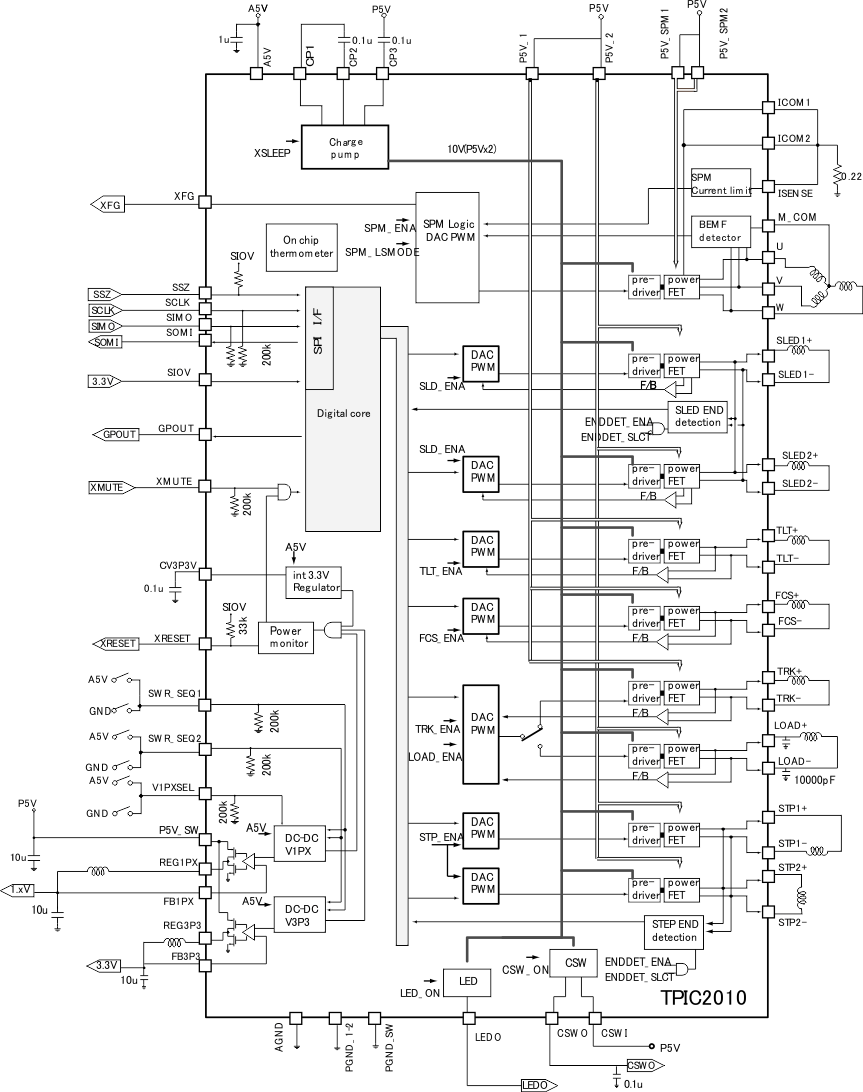
8.3 Feature Description
8.3.1 Protection Functions
TPIC2010 has five protection features: undervoltage lockout, overvoltage protection (OVP), over currentprotection (OCP), thermal protection (TSD), and actuator temperature protection (ACTTIMER) in order to protect target equipment. A protect behavior differ by generated events.
8.3.1.1 Undervoltage Lockout (UVLO)
Power Faults are reported in the UVLOMon register. Each UVLOMon bit will be initialized to zero upon a cold power up. After a fault is detected the appropriate fault bit will be latched high. Writing to the RST_ERRFLG (REG77) will clear all UVLOMon bits. The power device faults and actions are summarized in Table 1.
Table 1. Power Fault Monitor
| FAULT TYPE | LATCHED REGISTER | XRESET | CRITERIA | SPM | ACTUATOR | DC-DC |
|---|---|---|---|---|---|---|
| A5V under voltage | UVLO_A5V | Yes | <3.7 V | Hi-Z | Hi-Z | Hi-Z Feedback pin to GND |
| internal 3.3V under voltage | UVLO_INT3P3 | Yes | <2.7 V | Hi-Z | Hi-Z | Hi-Z |
| 3.3V DC-DC output under voltage | UVLO_SWR3P3 | Yes | <80% | Hi-Z | Hi-Z | |
| 1.xV DC-DC output under-voltage | UVLO_SWR1PX | Yes | <80% | Hi-Z | Hi-Z | |
| P5V over-voltage | OVP_P5V | >6.2 V | Brake | — | — | |
| >6.5 V | Hi-Z | Hi-Z | Hi-Z |
8.3.1.2 Overvoltage Protection (OVP)
Over voltage protect function is aimed to protect the unit from the supplying hi-voltage.
When the supply voltage exceeds 6.5 V, all driver and DC-DC converter output goes Hi-Z. When the supply voltage falls below typical 6.2 V, (6.0 V for SPM) all output start to operate again. The OVP and POR (XRESET) function is not interlocking. However, DC-DC converter output falls by Hi-Z operations, output voltage falls to 80% then XRESET signal goes low.
Moreover, when power supply exceeds 6.2 V, especially SPM enter short brake mode. This operation is offered supposing a voltage rising by motor BEMF of the high velocity revolution.
This function is for insurance, so it can not assure that the device is safety in the condition. Because the absolute maximum ratings range of the supply voltage is 6 V. When this function works, the feed back terminals are not shorted to GND.
Figure 6 shows the behavior of OVP.
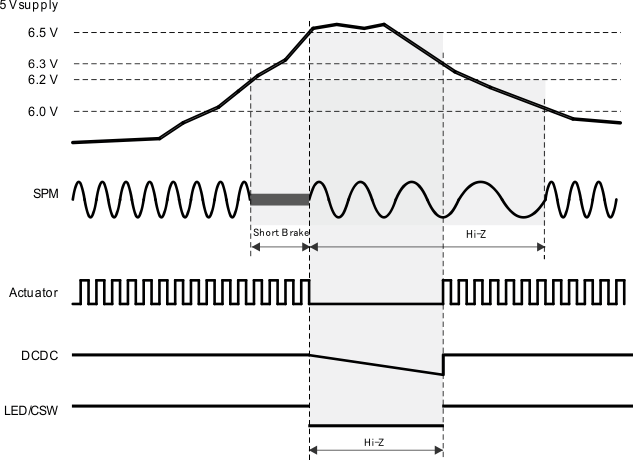 Figure 6. Overvoltage Protection
Figure 6. Overvoltage Protection
8.3.1.3 Overcurrent Protection (OCP)
The OCP function serve to protect the device from break down by large current. The OCP is provided for five circuit blocks, and each threshold are in Table 2.
Table 2. OCP Threshold
| BLOCK | DETECTION CURRENT | MONITOR TIME | HI-Z HOLD TIME |
|---|---|---|---|
| DC-DC conv V1PX V3P3 |
1850 mA | 1 ms | POR |
| 1150 mA | 1 ms | POR | |
| LOAD driver 1 ch 0.5 ch |
100% | 800 ms | Forever |
| 260 mA | 800 ms | Forever | |
| STEP driver | 850 mA | 1 µs | 25 ms |
| LED driver | 100 mA | 20 µs | 0.4 ms |
| CSW driver | 1000 mA | 20 µs | 1.6 ms |
When the large current is detected on each block, device put the output FET to Hi-Z.
The amounts of currents and time have specified the detection threshold for every circuit block.
When OCP occurs, it returns automatically after expiring set Hi-Z period. However, it restricts, the POR is performed at OCP for DC-DC converter. It keeps XRESET=L and does not return forever. It’s necessary power ON/OFF actuation in order to make it release.
OCPERR (REG7F) and OCP flag (REG7B) are set at OCP detection.
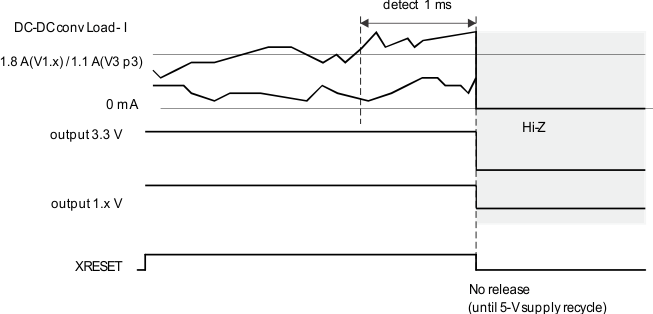 Figure 7. OCP DC-DC Converter
Figure 7. OCP DC-DC Converter
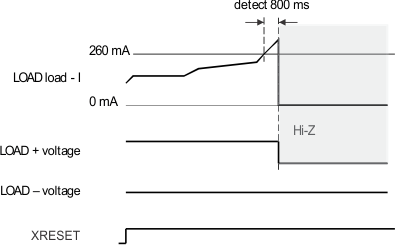 Figure 8. OCP Load 1-Channel
Figure 8. OCP Load 1-Channel
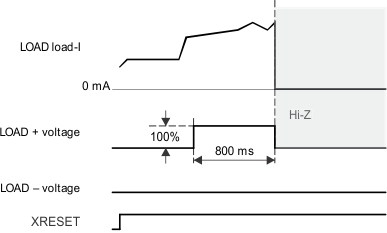 Figure 9. OCP Load 0.5-Channel
Figure 9. OCP Load 0.5-Channel
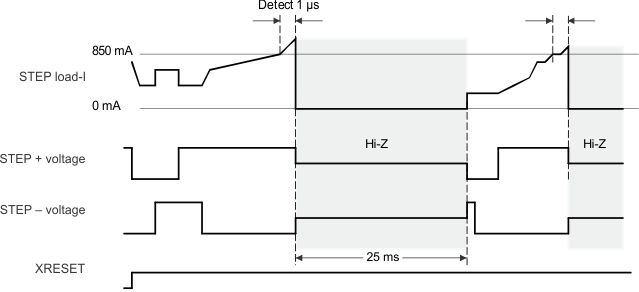
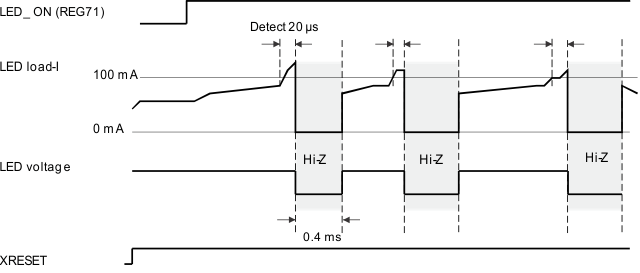 Figure 11. OCP LED Driver
Figure 11. OCP LED Driver
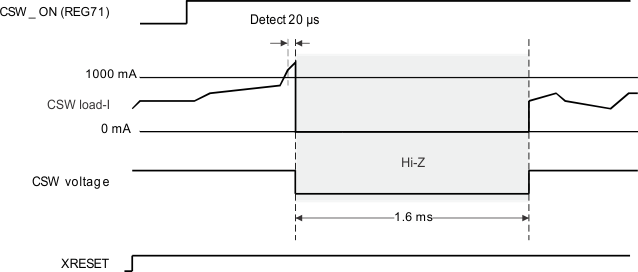 Figure 12. OCP Current Switch
Figure 12. OCP Current Switch
8.3.1.4 Thermal Protection (TSD)
The thermal protection (TSD) is a protect function which intercepts an output and suspends an operation when the IC temperature exceed a maximum permissible on a safety. TSD makes an output Hi-Z when the temperature rises up and a threshold value is exceeded. There’re two levels for threshold “Alert” and “Trip”. Alarm is given by status register “TSD_FAULT_” on “Alert” level with 135°C. It continues rising up temperature, the register “TSD_” is set at 150°C and the driver output changes HI-Z. If temperature falls and is reached 135°C, it will output again. TPIC2010 has total 12 temperature sensors in each circuit block. Particular sensor is assigned to appropriate status flag in List 10 OCP threshold.
Table 3. Thermal Sensor Assignment
| CIRCUIT | ALERT (°C) | TRIP (°C) | RELEASE (°C) | ALERT FLAG | TRIP FLAG |
|---|---|---|---|---|---|
| U | 130 | 145 | 130 | TSD_FAULT_SPM | TSD_SPM |
| V | 130 | 145 | 130 | TSD_FAULT_SPM | TSD_SPM |
| W | 130 | 145 | 130 | TSD_FAULT_SPM | TSD_SPM |
| TLT | 130 | 145 | 130 | TSD_FAULT_ACT | TSD_ACT |
| FCS | 130 | 145 | 130 | TSD_FAULT_ACT | TSD_ACT |
| TRC | 130 | 145 | 130 | TSD_FAULT_ACT | TSD_ACT |
| SLED1 | 130 | 145 | 130 | TSD_FAULT_ACT | TSD_ACT |
| SLED2 | 130 | 145 | 130 | TSD_FAULT_ACT | TSD_ACT |
| STP | 130 | 145 | 130 | TSD_FAULT_ACT | TSD_ACT |
| LOAD | 130 | 145 | 130 | TSD_FAULT_ACT | TSD_ACT |
| LED/CSW | 130 | 145 | 130 | TSD_FAULT_LEDCSW | TSD_ LEDCSW |
| 2ch DCDC | 130 | 145 | 130 | TSD_FAULT_SWR | TSD_SWR |
8.3.1.5 Actuator Temperature Protection (ACTTIMER)
TPIC2010 has Actuator protect function named ACTTIMER. This function enables to avoid from being broken by setting actuator channel output to HIZ when actuator coil current exceeds the specific value. Up to now, be used a simple actuator protect function such like exceeding max current with continuous time. However these types were not accurate. This new protection enables to calculate heat accumulation and judge correctly. When this function operates, load channel output will be Hi-Z, too. And spindle channel will be forced “Auto short brake” and disc motor will stop.
It’s able to know the protection has occurred by checking Fault register ACTTIMER_FAULT (REG7F) and ACT_TIMER_PROT (REG78). ACTTIMER_FAULT has a character of advance notice, is set before detecting ACT_TIMER_PROT. Once an ACT_TIMER_PROT is set, even if temperature falls, it will not release protection automatically. It’s necessary to clear the flag by setting RST_ERR_FLAG (REG77) or setting 0 to ACTTEMPTH (REG72). ACTTIMER function is able to disable by setting H to ACTPROT_OFF (REG72) or setting 0 to ACTTEMPTH (REG72).
In order to acquire the optimal value for ACTTEMPTH, you should set device into the condition of the detection level, and reading the value of ACTTEMP. Because of the present value can be read from ACTTEMP (REG78). (1)
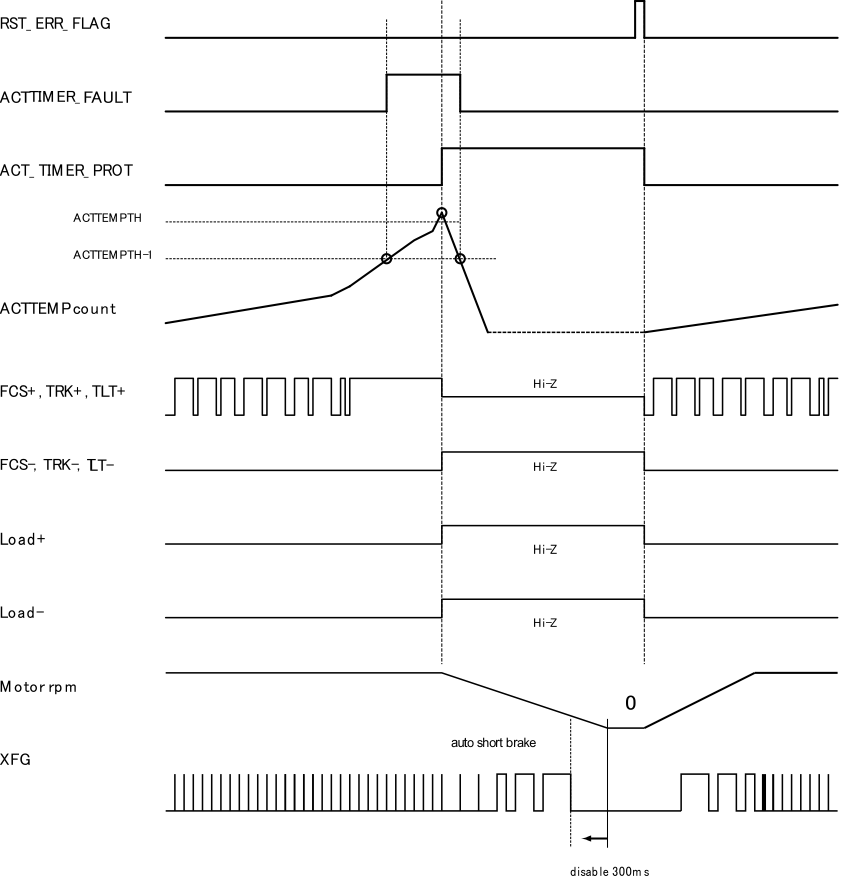 Figure 13. Actuator Temperature Protections
Figure 13. Actuator Temperature Protections
8.4 Device Functional Modes
8.4.1 Power-On Reset (POR)
8.4.1.1 Power-Up Sequences
The power up sequence is described in Table 4.
In TPIC2010, the normal sequence is to wait for 5-V supply to come up to 3.9 V. After 5 V establish, the internal 3.3 V will stabilize. Now the voltage monitors start to work and begin to look for the DC-DC V1Px and V3P3. Start up sequence for internal DC-DC converter is selected by external pin, SWR_SEQ1 and SWR_SEQ2. All DC-DC converters stabilize the power up sequence finishes and the part starts to function. Once the part finishes all of its power up tasks, it takes XRESET high to indicate that the part is no longer in reset and ready to communicate to the outside world. All the DC-DC converter have soft-start features to avoid rush current and voltage over shoot. Each soft-start sequence takes about 0.8 ms.
Table 4. DC-DC Start-Up Sequence and Output
| V1PXSEL | SWR_SEQ2 | SWR_SEQ1 | REG1PX(V) | REG3P3(V) | SEQUENCE | |
|---|---|---|---|---|---|---|
| REG1PX | REG3P3 | |||||
| 0 | 0 | 0 | 1.2 | 3.3 | Same | |
| 0 | 0 | 1 | 1.2 | 3.3 | 2nd | 1st |
| 0 | 1 | 0 | 1.2 | 3.3 | 1st | 2nd |
| 0 | 1 | 1 | 1.0 | 3.3 | Same | |
| 1 | 0 | 0 | 1.5 | 3.3 | Same | |
| 1 | 0 | 1 | 1.5 | 3.3 | 2nd | 1st |
| 1 | 1 | 0 | 1.5 | 3.3 | 1st | 2nd |
| 1 | 1 | 1 | Disable(1) | |||
![TPIC2010 Simultaneously Start
Up (SWR_SEQ[1:0] = 00) TPIC2010 simul_start_lis170.gif](/ods/images/SLIS170/simul_start_lis170.gif) Figure 14. Simultaneously Start Up (SWR_SEQ[1:0] = 00)
Figure 14. Simultaneously Start Up (SWR_SEQ[1:0] = 00)
![TPIC2010 V1Px Start First
(SWR_SEQ[1:0] = 10) TPIC2010 tim_V1Px_lis170.gif](/ods/images/SLIS170/tim_V1Px_lis170.gif) Figure 15. V1Px Start First (SWR_SEQ[1:0] = 10)
Figure 15. V1Px Start First (SWR_SEQ[1:0] = 10)
![TPIC2010 V3P3 Start First
(SWR_SEQ[1:0] = 01) TPIC2010 tim_V3P3_start_lis170.gif](/ods/images/SLIS170/tim_V3P3_start_lis170.gif) Figure 16. V3P3 Start First (SWR_SEQ[1:0] = 01)
Figure 16. V3P3 Start First (SWR_SEQ[1:0] = 01)
8.4.1.2 XRESET
TPIC2010 is preparing XRESET pin in order to notify an own status to DSP. TPIC2010 set XRESET to L when the event which has a serious effect on DSP occurs such like the power failure, the over temperature and the drop of DC-DC converter output. If all the exception is removed, it will tell that XRESET pin would be set to H and it would be in the ready state. The POR (power on reset) condition is shown in Figure 17. All the behavior of XRESET is shown in Figure 21.
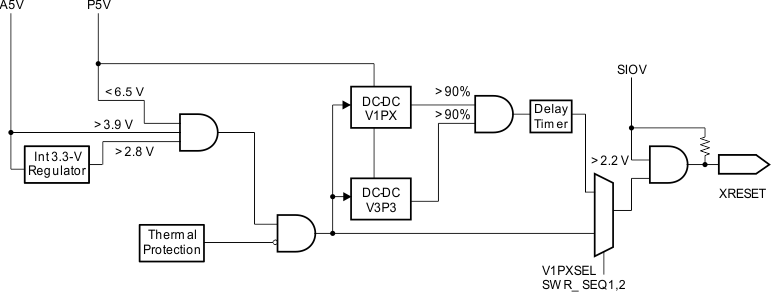 Figure 17. POR Block Diagram
Figure 17. POR Block Diagram
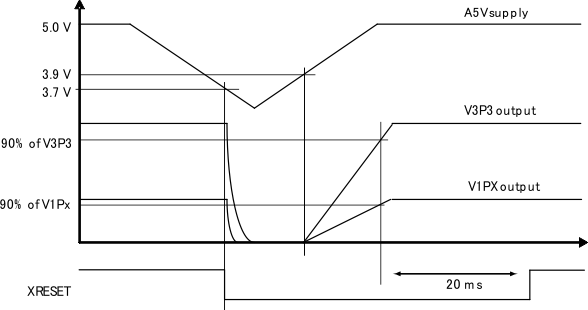 Figure 18. 5-V Supply Voltage Drop
Figure 18. 5-V Supply Voltage Drop
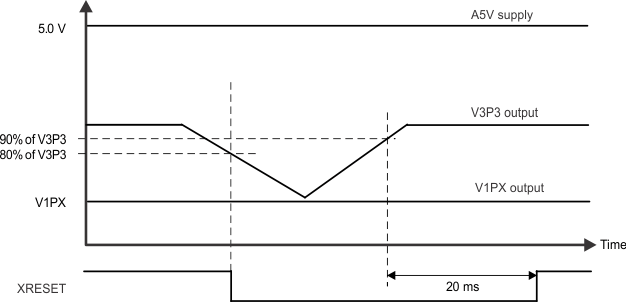 Figure 19. 3.3-V Output Voltage Drops (SWR_SEQ = 00, 11)
Figure 19. 3.3-V Output Voltage Drops (SWR_SEQ = 00, 11)
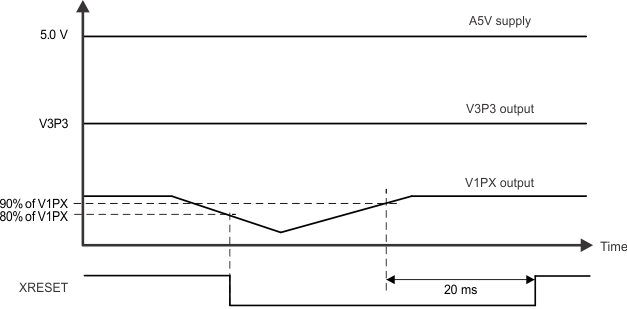 Figure 20. 1.x V Output Voltage Drops (SWR_SEQ = 00, 11)
Figure 20. 1.x V Output Voltage Drops (SWR_SEQ = 00, 11)
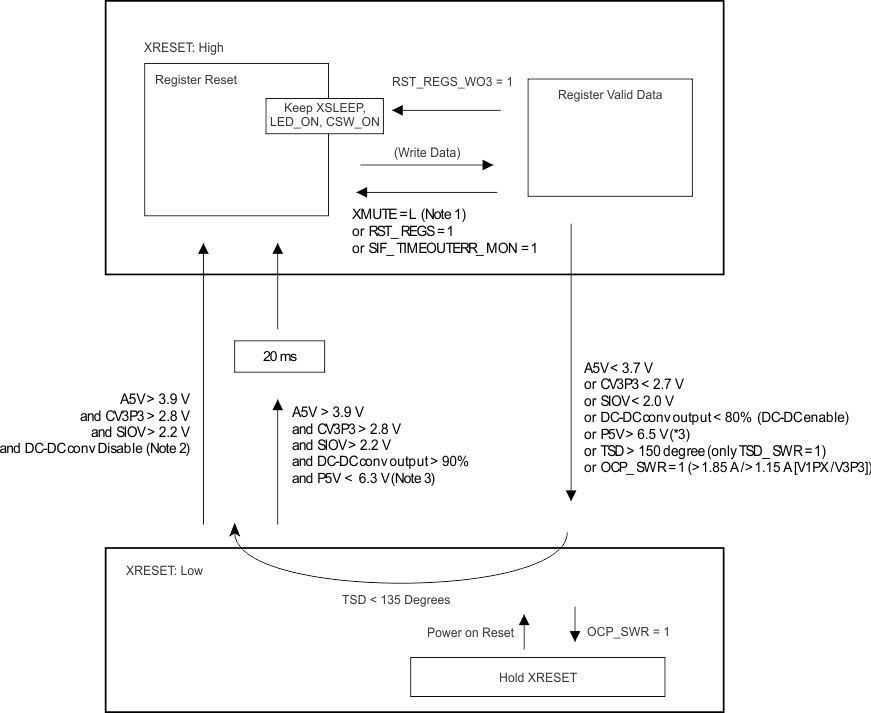
8.5 Programming
8.5.1 Function and Operation
8.5.1.1 Serial Port Functional Description
The serial communication of TPIC2010 is based on a SPI communications protocol. TPIC2010 is put on the slave side. All 16-bit transmission data is effective in SSZ = L period.
The bit stream sent through SIMO from a master (DSP) is latched to an internal shift register by the rising edge of SCLK. All the data is transmitted in a total of 16-bit format of a command and data. A format has two types of data, 8 bits and 12 bits length. In order to access specific registers, an address and R/W flag are specified as a command part. In addition, 12 bit data do not have R/W flag in the packet because DAC register (= 12-bit data form) are Write only. A transfer packet, command and data, is transmitted sequentially from MSB to LSB. A packet is distinguished in MSB 2 bits of command. In the case of 11, it handles a packet for control register access, and the other processed as a packet for a DAC data setting.
There are the following four kinds of serial-data communication packets.
- Write 12 bits DAC data (MSB two bit ≠ 11)
- Write 8 bits control register (MSB two bit = 11)
- Read 8 bits control register (MSB two bit = 11)
- Write 12 bits Focus DAC data+Read 8 bits status register at the same time (MSB two bit ≠ 11)
8.5.1.2 Write Operation
For write operation, DSP transmits 16 bit (command + address + data) data a bit every in an order from MSB. Only the 16-bit data which means 16 SCLK sent from the master during SSZ = L becomes effective. If more than 17 or less than 15 SCLK pulses are received during the time that SSZ is low, the whole packet will be ignored. For all valid write operations, the data of the shift register is latched into its designated internal register at rising edge of 16th SCLK. All internal register bits, except indicated otherwise, are reset to their default states upon power-on-reset.
 Figure 22. Write 12 Bits DAC Data
Figure 22. Write 12 Bits DAC Data
 Figure 23. Write 8 Bits Control Register
Figure 23. Write 8 Bits Control Register
8.5.1.3 Read Operation
DSP sends 8-bit header through SIMO, in order to perform Read operation. TPIC2010 will start to drive the SOMI line upon the eighth falling edge of SCLK and shift out eight data bits. The master DSP inputs 8bits data from SOMI after the ninth rising edge of SCLK. There’s optional read mode that SOMI data is advanced a half clock cycle of SCLK. This mode becomes effective by setting “ADVANCE_RD” (REG74) = H.
 Figure 24. Read 8 Bits Control Register
Figure 24. Read 8 Bits Control Register
8.5.1.4 Write and Read Operation
Optionally, the master DSP can read Status register during writing 12 bits DAC (Focus DAC) packet. It’s enabled by setting bit “RDSTAT_ON_VFCS” (REG74) = H.
 Figure 25. Write 12 Bits Focus DAC Data + Read 8 Bits Status Data
Figure 25. Write 12 Bits Focus DAC Data + Read 8 Bits Status Data
8.6 Register Maps
All registers are in WRITE-protect mode after XRESET release. “WRITE_ENA” bit (REG76) = H is required before writing data in register.
8.6.1 Register State Transition
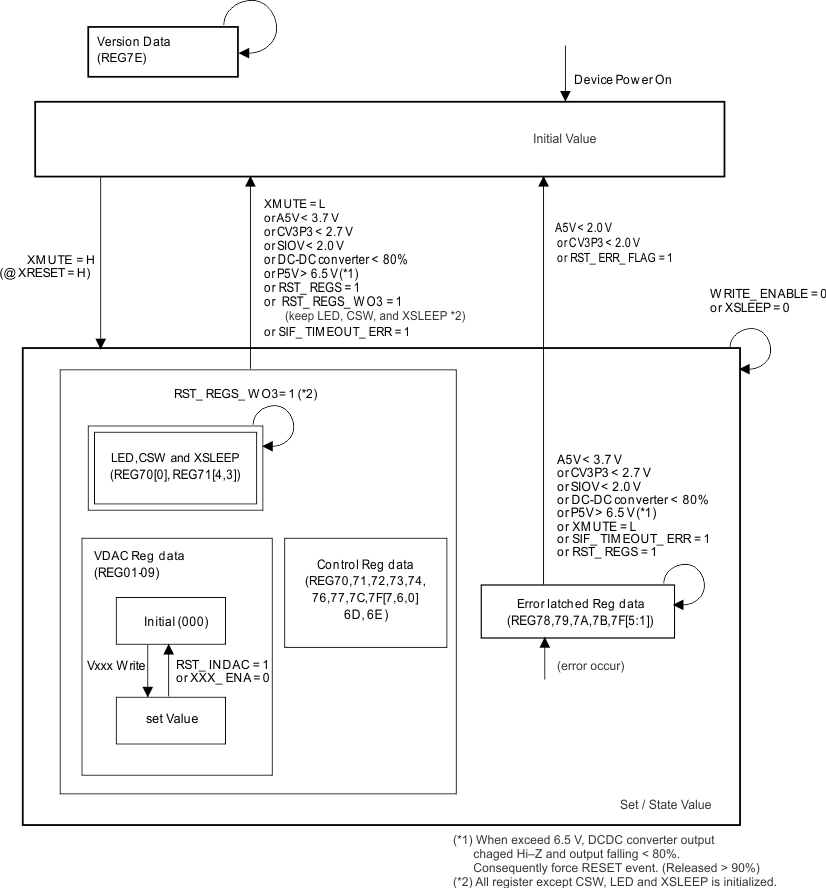
8.6.2 DAC Register (12-Bit Write Only)
Two difference forms are prepared in 12-bit DAC register, and the forms can be selected by setting VDAC_MAPSW (REG74h).
Table 5. DAC Register (VDAC_MAPSW = 0)
| REG | NAME | F | 11 | 10 | 9 | 8 | 7 | 6 | 5 | 4 | 3 | 2 | 1 | 0 |
|---|---|---|---|---|---|---|---|---|---|---|---|---|---|---|
| 00h | N/A | W | N/A | N/A | N/A | |||||||||
| 01h | VTLT | W | VTLT[11] | VTLT[10] | VTLT[9] | VTLT[8] | VTLT[7] | VTLT[6] | VTLT[5] | VTLT[4] | VTLT[3] | VTLT[2] | VTLT[1] | VTLT[0] |
| 02h | VFCS | W | VFCS[11] | VFCS[10] | VFCS[9] | VFCS[8] | VFCS[7] | VFCS[6] | VFCS[5] | VFCS[4] | VFCS[3] | VFCS[2] | VFCS[1] | VFCS[0] |
| 03h | VTRK | W | VTRK[11] | VTRK[10] | VTRK[9] | VTRK[8] | VTRK[7] | VTRK[6] | VTRK[5] | VTRK[4] | VTRK[3] | VTRK[2] | VTRK[1] | VTRK[0] |
| 04h | VSLD1 | W | VSLD1[11] | VSLD1[10] | VSLD1[9] | VSLD1[8] | VSLD1[7] | VSLD1[6] | VSLD1[5] | VSLD1[4] | VSLD1[3] | VSLD1[2] | VSLD1[1](1) | VSLD1[0](1) |
| 05h | VSLD2 | W | VSLD2[11] | VSLD2[10] | VSLD2[9] | VSLD2[8] | VSLD2[7] | VSLD2[6] | VSLD2[5] | VSLD2[4] | VSLD2[3] | VSLD2[2] | VSLD2[1](1) | VSLD2[0](1) |
| 06h | VSTP1 | W | VSTP1[11] | VSTP1[10] | VSTP1[9] | VSTP1[8] | VSTP1[7] | VSTP1[6] | VSTP1[5] | VSTP1[4] | VSTP1[3](1) | VSTP1[2](1) | VSTP1[1](1) | VSTP1[0](1) |
| 07h | VSTP2 | W | VSTP2[11] | VSTP2[10] | VSTP2[9] | VSTP2[8] | VSTP2[7] | VSTP2[6] | VSTP2[5] | VSTP2[4] | VSTP2[3](1) | VSTP2[2](1) | VSTP2[1](1) | VSTP2[0](1) |
| 08h | VSPM | W | VSPM[11] | VSPM[10] | VSPM[9] | VSPM[8] | VSPM[7] | VSPM[6] | VSPM[5] | VSPM[4] | VSPM[3] | VSPM[2] | VSPM[1] | VSPM[0] |
| 09h | VLOAD | W | VLOAD[11] | VLOAD[10] | VLOAD[9] | VLOAD[8] | VLOAD[7] | VLOAD[6] | VLOAD[5] | VLOAD[4] | VLOAD[3] | VLOAD[2] | VLOAD[1] | VLOAD[0] |
| 0Ah | N/A | W | N/A | N/A | N/A | |||||||||
| 0Bh | N/A | W | N/A | N/A | N/A | |||||||||
Table 6. DAC Register (VDAC_MAPSW = 1)
| REG | NAME | F | 11 | 10 | 9 | 8 | 7 | 6 | 5 | 4 | 3 | 2 | 1 | 0 |
|---|---|---|---|---|---|---|---|---|---|---|---|---|---|---|
| 00h | N/A | W | N/A | N/A | N/A | |||||||||
| 01h | VTLT | W | VTRK[11] | VTRK[10] | VTRK[9] | VTRK[8] | VTRK[7] | VTRK[6] | VTRK[5] | VTRK[4] | VTRK[3] | VTRK[2] | VTRK[1] | VTRK[0] |
| 02h | VFCS | W | VFCS[11] | VFCS[10] | VFCS[9] | VFCS[8] | VFCS[7] | VFCS[6] | VFCS[5] | VFCS[4] | VFCS[3] | VFCS[2] | VFCS[1] | VFCS[0] |
| 03h | VTRK | W | VTLT[11] | VTLT[10] | VTLT[9] | VTLT[8] | VTLT[7] | VTLT[6] | VTLT[5] | VTLT[4] | VTLT[3] | VTLT[2] | VTLT[1] | VTLT[0] |
| 04h | VSLD1 | W | VSLD1[11] | VSLD1[10] | VSLD1[9] | VSLD1[8] | VSLD1[7] | VSLD1[6] | VSLD1[5] | VSLD1[4] | VSLD1[3] | VSLD1[2] | VSLD1[1](1) | VSLD1[0](1) |
| 05h | VSLD2 | W | VSLD2[11] | VSLD2[10] | VSLD2[9] | VSLD2[8] | VSLD2[7] | VSLD2[6] | VSLD2[5] | VSLD2[4] | VSLD2[3] | VSLD2[2] | VSLD2[1](1) | VSLD2[0](1) |
| 06h | VSTP1 | W | VSPM[11] | VSPM[10] | VSPM[9] | VSPM[8] | VSPM[7] | VSPM[6] | VSPM[5] | VSPM[4] | VSPM[3] | VSPM[2] | VSPM[1] | VSPM[0] |
| 07h | VSTP2 | W | N/A | N/A | N/A | |||||||||
| 08h | VSPM | W | N/A | N/A | N/A | |||||||||
| 09h | VLOAD | W | N/A | VLOAD[11] | VLOAD[10] | VLOAD[9] | VLOAD[8] | VLOAD[7] | VLOAD[6] | VLOAD[5] | VLOAD[4] | |||
| 0Ah | N/A | W | N/A | VSTP1[11] | VSTP1[10] | VSTP1[9] | VSTP1[8] | VSTP1[7] | VSTP1[6] | VSTP1[5] | VSTP1[4] | |||
| 0Bh | N/A | W | N/A | VSTP2[11] | VSTP2[10] | VSTP2[9] | VSTP2[8] | VSTP2[7] | VSTP2[6] | VSTP2[5] | VSTP2[4] | |||
8.6.3 Control Register (8-Bit Read/Write)
Table 7. Control Register(1)
| REG | NAME | F | 7 | 6 | 5 | 4 | 3 | 2 | 1 | 0 |
|---|---|---|---|---|---|---|---|---|---|---|
| 70h | DriverEna | R/W | TLT_ENA | FCS_ENA | TRK_ENA | SPM_ENA | SLD_ENA | STP_ENA | LOAD_ENA | XSLEEP |
| 71h | FuncEna | R/W | SPM_LSMODE | ENDDET_ENA | ENDDET_SLCT | LED_ON | CSW_ON | TEMPMON_ENA | TI reserved | |
| 72h | ACTCfg | R/W | LOAD_O5CH_HIGH | LOADPROT_OFF | ACTPROT_OFF | ACTTEMPTH | ||||
| 73h | Parm0 | R/W | SIF_TIMEOUT_TH | SLDEND_HZTIME | SLDENDTH | STPEND_HZTIME | STPENDTH | |||
| 74h | SIFCfg | R/W | DIFF_TLT | LOAD05_CH | RDSTAT_ON_VFCS | VSLD2_POL | VSTP2_POL | ADVANCE_RD | SOMI_HIZ | VDAC_MAPSW |
| 75h | Protect | R/W | TI reserved | |||||||
| 76h | WriteEna | R/W | WRITE_ENABLE | TI reserved | REG6X_WR | |||||
| 77h | ClrReg | W | RST_INDAC | RST_REGS | RST_ERR_FLAG | RST_REGS_WO3 | TI reserved | |||
| 78h | ActTemp | R | TI reserved | ACT_TIMER_PROT | ACTTEMP | |||||
| 79h | UVLOMon | R | TI reserved | UVLO_A5V | UVLO_INT3P3 | UVLO_SWR3P3 | UVLO_SWR1PX | OVP_P5V | ||
| 7Ah | ThPMon | R | TSD_FAULT_SWR | TSD_FAULT_SPM | TSD_FAULT_ACT | TSD_FAULT_LEDCSW | TSD_SWR | TSD_SPM | TSD_ACT | TSD_ LEDCSW |
| 7Bh | OCPMon | R | TI reserved | OCP_SWR | OCP_STP | OCP_LOAD | OCP_LED | OCP_CSW | ||
| 7Ch | TempMon | R | TI reserved | CHIPTEMP_STATUS | CHIPTEMP | |||||
| 7Dh | Protect | R | TI reserved | |||||||
| 7Eh | Version | R | Version | |||||||
| 7Fh | Status | R | ACTTIMER_FAULT | ENDDET | SIF_TIMEOUTERR | PWRERR | TSDERR | OCPERR | TSDFAULT | FG |
| 60h | Protect | R/W | TI reserved | |||||||
| 61h | Protect | R/W | TI reserved | |||||||
| 62h | Protect | R/W | TI reserved | |||||||
| 63h | SpinAdj | R/W | TI reserved | Mask_Plus | TI reserved | |||||
| 64h | Protect | R/W | TI reserved | |||||||
| 65h | Protect | R/W | TI reserved | |||||||
| 66h | Protect | R/W | TI reserved | |||||||
| 6Ch | EdetCfg | R/W | TI reserved | STP_WIND_HIZ | STP_WIND_H | |||||
| 6Dh | DCCfg | R/W | SWR1_MD_BURST | SWR2_MD_BURST | SWR1_VOUTUP | TI reserved | SWR1_BST_HEFF | TI reserved | ||
| 6Eh | UtilCfg | R/W | GPOUT_HL | GPOUT_ENA | SWROCP_SELCLK | TI reserved | SWR1_GPIO_CNTL | SWR2_GPIO_CNTL | ||
| 6Fh | MonitorSet | R/W | ACTTIMER_FLT_MON | ENDDET_MON | SIF_TIMEOUTERR_MON | PWRERR_MON | TSDERR_MON | OCPERR_MON | TSDFAULT_MON | TI reserved |
8.6.4 Detailed Description of Register
8.6.4.1 REG01 12-Bit DAC for Tilt
| 15 | 14 | 13 | 12 | 11 | 10 | 9 | 8 |
| VTLT | |||||||
| w-0 | w-0 | w-0 | w-0 | ||||
| 7 | 6 | 5 | 4 | 3 | 2 | 1 | 0 |
| VTLT | |||||||
| w-0 | w-0 | w-0 | w-0 | w-0 | w-0 | w-0 | w-0 |
| LEGEND: R/W = Read/Write; R = Read only; -n = value after reset |
Table 8. Tilt (REG01) Field Descriptions
| Bit | Field | Type | Default | Description |
|---|---|---|---|---|
| 11-0 | VTLT | w-0 | Digital input code for Tilt. 2’s complement format 0x800(-2048) to 0x7ff(+2047) Output is changed by “differential Tilt mode (REG74[7])” TLT_OUT = VTLT × (6.0 / 2048) (DIFF_TLT = 0) TLT_OUT = (VFCS-VTLT) × (6.0 / 2048) (DIFF_TLT = 1) TLT_OUT should be changed after writing VFCS. In DIFF_TLT mode (DIFF_TLT = 1), TLT_OUT should be changed after writing VFCS. |
8.6.4.2 REG02 12-Bit DAC for Focus
| 15 | 14 | 13 | 12 | 11 | 10 | 9 | 8 |
| VFCS | |||||||
| w-0 | w-0 | w-0 | w-0 | ||||
| 7 | 6 | 5 | 4 | 3 | 2 | 1 | 0 |
| VFCS | |||||||
| w-0 | w-0 | w-0 | w-0 | w-0 | w-0 | w-0 | w-0 |
| LEGEND: R/W = Read/Write; R = Read only; -n = value after reset |
Table 9. Focus (REG02) Field Descriptions
| Bit | Field | Type | Default | Description |
|---|---|---|---|---|
| 11-0 | VFCS | w-0 | Digital input code for Focus 2’s complement format 0x800(-2048) to 0x7ff(+2047) Output is changed by “differential Tilt mode (REG74[7])” FCS_OUT = VFCS × (6.0 / 2048) (DIFF_TLT = 0) FCS_OUT = (VFCS – VTLT) × (6.0 / 2048) (DIFF_TLT = 1) |
8.6.4.3 REG03 12-Bit DAC for Tracking
| 15 | 14 | 13 | 12 | 11 | 10 | 9 | 8 |
| VTRK | |||||||
| w-0 | w-0 | w-0 | w-0 | ||||
| 7 | 6 | 5 | 4 | 3 | 2 | 1 | 0 |
| VTRK | |||||||
| w-0 | w-0 | w-0 | w-0 | w-0 | w-0 | w-0 | w-0 |
| LEGEND: R/W = Read/Write; R = Read only; -n = value after reset |
Table 10. Tracking (REG03) Field Descriptions
| Bit | Field | Type | Default | Description |
|---|---|---|---|---|
| 11-0 | VTRK | w-0 | Digital input code for Tracking. 2’s complement format 0x800(-2048) to 0x7ff(+2047) TRK_OUT = VTRK × (6.0 / 2048) |
8.6.4.4 REG04 12-Bit DAC for Sled1
| 15 | 14 | 13 | 12 | 11 | 10 | 9 | 8 |
| VSLD1 | |||||||
| w-0 | w-0 | w-0 | w-0 | ||||
| 7 | 6 | 5 | 4 | 3 | 2 | 1 | 0 |
| VSLD1 | |||||||
| w-0 | w-0 | w-0 | w-0 | w-0 | w-0 | w-0 | w-0 |
| LEGEND: R/W = Read/Write; R = Read only; -n = value after reset |
Table 11. Sled1 (REG04) Field Descriptions
| Bit | Field | Type | Default | Description |
|---|---|---|---|---|
| 11-2 | VSLD1 | w-0 | Digital input code for Sled1. 2’s complement format 0x800(-2048) to 0x7ff(+2047) Two bits on LSB, VSLD1[1:0], will be handled with zero. SLD1_OUT = VSLD1 × (440mA/2048) |
8.6.4.5 REG05 12-Bit DAC for Sled2
| 15 | 14 | 13 | 12 | 11 | 10 | 9 | 8 |
| VSLD2 | |||||||
| w-0 | w-0 | w-0 | w-0 | ||||
| 7 | 6 | 5 | 4 | 3 | 2 | 1 | 0 |
| VSLD2 | |||||||
| w-0 | w-0 | w-0 | w-0 | w-0 | w-0 | w-0 | w-0 |
| LEGEND: R/W = Read/Write; R = Read only; -n = value after reset |
Table 12. Sled2 (REG05) Field Descriptions
| Bit | Field | Type | Default | Description |
|---|---|---|---|---|
| 11-2 | VSLD2 | w-0 | Digital input code for Sled2. 2’s complement format 0x800(-2048) to 0x7ff(+2047) Two bits on LSB, VSLD2[1:0], will be handled with zero. SLD2_OUT = VSLD2 × (440mA/2048) |
8.6.4.6 REG06 12-Bit DAC for Stepping1
| 15 | 14 | 13 | 12 | 11 | 10 | 9 | 8 |
| VSTP1 | |||||||
| w-0 | w-0 | w-0 | w-0 | ||||
| 7 | 6 | 5 | 4 | 3 | 2 | 1 | 0 |
| VSTP1 | |||||||
| w-0 | w-0 | w-0 | w-0 | w-0 | w-0 | w-0 | w-0 |
| LEGEND: R/W = Read/Write; R = Read only; -n = value after reset |
Table 13. Stepping1 (REG06) Field Descriptions
| Bit | Field | Type | Default | Description |
|---|---|---|---|---|
| 11-4 | VSTP1 | w-0 | Digital input code for Stepping1. 2’s complement format 0x800(-2048) to 0x7ff(+2047) Four bits on LSB, VSTP1[3:0], will be handled with zero. VSTP1_OUT = VSTP1 × (5.0/2048) @P5V=5.0V |
8.6.4.7 REG07 12-Bit DAC for Stepping2
| 15 | 14 | 13 | 12 | 11 | 10 | 9 | 8 |
| VSTP2 | |||||||
| w-0 | w-0 | w-0 | w-0 | ||||
| 7 | 6 | 5 | 4 | 3 | 2 | 1 | 0 |
| VSTP2 | |||||||
| w-0 | w-0 | w-0 | w-0 | w-0 | w-0 | w-0 | w-0 |
| LEGEND: R/W = Read/Write; R = Read only; -n = value after reset |
Table 14. Stepping2 (REG07) Field Descriptions
| Bit | Field | Type | Default | Description |
|---|---|---|---|---|
| 11-4 | VSTP2 | w-0 | Digital input code for Stepping1. 2’s complement format 0x800(-2048) to 0x7ff(+2047) Four bits on LSB, VSTP2[3:0], will be handled with zero. VSTP2_OUT = VSTP2 × (5.0/2048) @P5V=5.0V |
8.6.4.8 REG08 12-Bit DAC for Spindle
| 15 | 14 | 13 | 12 | 11 | 10 | 9 | 8 |
| VSPM | |||||||
| w-0 | w-0 | w-0 | w-0 | ||||
| 7 | 6 | 5 | 4 | 3 | 2 | 1 | 0 |
| VSPM | |||||||
| w-0 | w-0 | w-0 | w-0 | w-0 | w-0 | w-0 | w-0 |
| LEGEND: R/W = Read/Write; R = Read only; -n = value after reset |
Table 15. Spindle (REG08) Field Descriptions
| Bit | Field | Type | Default | Description |
|---|---|---|---|---|
| 11-0 | VSPM | w-0 | Digital input code for Spindle. 2’s complement format 0x800(-2048) to 0x7ff(+2047) SPM_OUT = VSPM × (6.0 / 2048) |
8.6.4.9 REG09 12-Bit DAC for Load
| 15 | 14 | 13 | 12 | 11 | 10 | 9 | 8 |
| VLOAD | |||||||
| w-0 | w-0 | w-0 | w-0 | ||||
| 7 | 6 | 5 | 4 | 3 | 2 | 1 | 0 |
| VLOAD | |||||||
| w-0 | w-0 | w-0 | w-0 | w-0 | w-0 | w-0 | w-0 |
| LEGEND: R/W = Read/Write; R = Read only; -n = value after reset |
Table 16. Load (REG09) Field Descriptions
| Bit | Field | Type | Default | Description |
|---|---|---|---|---|
| 11-0 | VLOAD | w-0 | Digital input code for Load. 2’s complement format 0x800(-2048) to 0x7ff(+2047) LOAD_OUT = VLOAD × (6.0 / 2048) |
8.6.4.10 REG63 8-Bit Control Register for SpinAdj
| 7 | 6 | 5 | 4 | 3 | 2 | 1 | 0 |
| TI reserved | Mask_Plus | TI reserved | |||||
| rw-0 | rw-0 | rw-0 | rw-0 | rw-0 | rw-0 | rw-0 | rw-0 |
| LEGEND: R/W = Read/Write; R = Read only; -n = value after reset |
Table 17. SpinAdj (REG63) Field Descriptions
| Bit | Field | Type | Default | Description |
|---|---|---|---|---|
| 7-2 | TI reserved | r-0 | ||
| 1 | Mask_Plus | r-0 | 0 | Mask Plus bit enables fly back robustness by optimizing masking time. 0: Default masking time 1: Extended masking time for large inductance motor |
| 0 | TI reserved | r-0 |
8.6.4.11 REG6C 8-Bit Control Register for EDetCfg
| 7 | 6 | 5 | 4 | 3 | 2 | 1 | 0 |
| TI reserved | STP_WIND_HIZ | STP_WIND_H | |||||
| rw-0 | rw-0 | rw-0 | rw-0 | rw-0 | rw-0 | rw-0 | rw-0 |
| LEGEND: R/W = Read/Write; R = Read only; -n = value after reset |
Table 18. EDetCfg (REG6C) Field Descriptions
| Bit | Field | Type | Default | Description |
|---|---|---|---|---|
| 7-2 | TI reserved | r-0 | ||
| 1 | STP_WIND_HIZ | r-0 | 0 | 0: normal end detection 1: when detecting BEMF, set STP1 and STP2 FET HIZ to reduce mutual noise. |
| 0 | STP_WIND_H | r-0 | 0 | 0: normal end detection 1: when detecting BEMF, set driving phase to Hi ( Detecting phase put Hi-Z ) to reduce mutual noise. |
8.6.4.12 REG6D 8-Bit Control Register for DCCfg
| 7 | 6 | 5 | 4 | 3 | 2 | 1 | 0 |
| SWR1_MD_BURST | SWR2_MD_BURST | SWR1_VOUTUP | TI reserved | SWR1_BST_HEFF | TI reserved | ||
| rw-0 | rw-0 | rw-0 | rw-0 | rw-0 | rw-0 | rw-0 | rw-0 |
| LEGEND: R/W = Read/Write; R = Read only; -n = value after reset |
Table 19. DCCfg (REG6D) Field Descriptions
| Bit | Field | Type | Default | Description |
|---|---|---|---|---|
| 7 | SWR1_MD_BURST | rw-0 | 0 | 0: V1Px normal regulation 1: V1Px discontinuous mode |
| 6 | SWR2_MD_BURST | rw-0 | 0 | 0: V3P3 normal regulation 1: V3P3 discontinuous mode |
| 5-4 | SWR1_VOUTUP | rw-0 | 0 | V1Px DC-DC converter voltage up For 1.2 V or 1.5 V: 00: 0% 01: 2% 10: 3.6% 11: 5.5% For 1.0 V: 00: 0% 01: 1.3% 10: 2.4% 11: 3.3% |
| 3 | TI reserved | rw-0 | ||
| 2 | SWR1_BST_HEFF | rw-0 | 0 | 1: V1Px High efficiency mode on discontinuous mode This bit will be enabled in SWR1_MD_BURST=1 |
| 1-0 | TI reserved | rw-0 |
8.6.4.13 REG6E 8-Bit Control Register for UtilCfg
| 7 | 6 | 5 | 4 | 3 | 2 | 1 | 0 |
| GPOUT_HL | GPOUT_ENA | SWROCP_SELCLK | TI reserved | SWR1_GPIO_CNTL | SWR2_GPIO_CNTL | ||
| rw-0 | rw-0 | rw-0 | rw-0 | rw-0 | rw-0 | rw-0 | rw-0 |
| LEGEND: R/W = Read/Write; R = Read only; -n = value after reset |
Table 20. UtilCfg (REG6E) Field Descriptions
| Bit | Field | Type | Default | Description |
|---|---|---|---|---|
| 7 | GPOUT_HL | rw-0 | 0 | GPOUT (general-purpose output) pin output selection 0: low output 1: high output valid only REG6F = 00h |
| 6 | GPOUT_ENA | rw-0 | 0 | Enable monitor signal output to GPOUT pin 0: No signal output, Hi-Z 1: output signal selected in REG6F with CMOS output Output is Logical OR when selected two more signals |
| 5-4 | SWROCP_SELCLK | rw-0 | 0 | Over current protection monitoring frequency 5 counts by 00: 5 kHz (= exceed 1 ms) 01: 20 kHz 10: 50 kHz 11: 500 kHz |
| 3-2 | TI reserved | rw-0 | ||
| 1 | SWR1_GPIO_CNTL | rw-0 | 0 | Set REG1PX pin as GPIO1 pin. 0: REG1PX pin as 1.xV DC-DC converter output 1: Open drain control for GPOUT1 pin (at V1Px DC-DC disable) |
| 0 | SWR2_GPIO_CNTL | rw-0 | 0 | Set REG3P3 pin as GPIO2 pin. 0: REG3P3 pin as 3.3V DC-DC converter output 1: Open drain control for GPOUT1 pin (at V1Px DC-DC disable) Open drain control for GPOUT2 pin (at V3P3 DC-DC disable) |
8.6.4.14 REG6F 8-Bit Control Register for MonitorSet
| 7 | 6 | 5 | 4 | 3 | 2 | 1 | 0 |
| ACTTIMER_FLT_MON | ENDDET_MON | SIF_TIMEOUTERR_MON | PWRERR_MON | TSDERR_MON | OCPERR_MON | TSDFAULT_MON | TI reserved |
| rw-0 | rw-0 | rw-0 | rw-0 | rw-0 | rw-0 | rw-0 | rw-0 |
| LEGEND: R/W = Read/Write; R = Read only; -n = value after reset |
Table 21. MonitorSet (REG6F) Field Descriptions
| Bit | Field | Type | Default | Description |
|---|---|---|---|---|
| 7 | ACTTIMER_FLT_MON | rw-0 | 0 | 1: ACTTIMER fault output to GPOUT pin |
| 6 | ENDDET_MON | rw-0 | 0 | 1: ENDDET monitor output to GPOUT pin |
| 5 | SIF_TIMEOUTERR_MON | rw-0 | 0 | 1: SIF timeout monitor output to GPOUT pin |
| 4 | PWRERR_MON | rw-0 | 0 | 1: PWRERR monitor output to GPOUT pin |
| 3 | TSDERR_MON | rw-0 | 0 | 1: TSDERR fault output to GPOUT pin |
| 2 | OCPERR_MON | rw-0 | 0 | 1: OCPERR fault output to GPOUT pin |
| 1 | TSDFAULT_MON | rw-0 | 0 | 1: TSDFAULT fault output to GPOUT pin |
8.6.4.15 REG70 8bit Control Register for DriverEna
| 7 | 6 | 5 | 4 | 3 | 2 | 1 | 0 |
| TLT_ENA | FCS_ENA | TRK_ENA | SPM_ENA | SLD_ENA | STP_ENA | LOAD_ENA | XSLEEP |
| rw-0 | rw-0 | rw-0 | rw-0 | rw-0 | rw-0 | rw-0 | rw-0 |
| LEGEND: R/W = Read/Write; R = Read only; -n = value after reset |
Table 22. DriverEna (REG70) Field Descriptions
| Bit | Field | Type | Default | Description |
|---|---|---|---|---|
| 7 | TLT_ENA | rw-0 | 1 : Tilt enable (with XSLEEP=1) | |
| 6 | FCS_ENA | rw-0 | 1: Focus enable (with XSLEEP=1) | |
| 5 | TRK_ENA | rw-0 | 1: Track enable (with XSLEEP=1) | |
| 4 | SPM_ENA | rw-0 | 1: Spindle enable (with XSLEEP=1) | |
| 3 | SLD_ENA | rw-0 | 1: Sled enable (with XSLEEP=1) | |
| 2 | STP_ENA | rw-0 | 1: Step enable (with XSLEEP=1) | |
| 1 | LOAD_ENA | rw-0 | 1 : LOAD enable (with XSLEEP=1) Track (bit5:TRK_ENA) will be disabled at LOAD_ENA=1 because of sharing the DAC PWM module. Load priority is higher than TRK_ENA. |
|
| 0 | XSLEEP | rw-0 | 1: Operation mode 0: Power save mode Charge pump enable bit. All driver enable bit (Bit[7:1]) change disabled and output change to Hi-Z (regardless of setting xxx_ENA bit is 1 when setting XSLEEP to 0. Therefore set 1 to XSLEEP before setting each enable bits. |
8.6.4.16 REG71 8-Bit Control Register for FuncEna
| 7 | 6 | 5 | 4 | 3 | 2 | 1 | 0 |
| SPM_LSMODE | ENDDET_ENA | ENDDET_SLCT | LED_ON | CSW_ON | TEMPMON_ENA | TI reserved | |
| rw-0 | rw-0 | rw-0 | rw-0 | rw-0 | rw-0 | rw-0 | rw-0 |
| LEGEND: R/W = Read/Write; R = Read only; -n = value after reset |
Table 23. FuncEna (REG71) Field Descriptions
| Bit | Field | Type | Default | Description |
|---|---|---|---|---|
| 7 | SPM_LSMODE | rw-0 | 0 : Spindle Normal rotation mode 1 : Light Scribe mode (slow rotation mode) |
|
| 6 | ENDDET_ENA | rw-0 | 1 : use sled/step End detection enable ( with STP_ENA=1 or SLD_ENA=1) | |
| 5 | ENDDET_SLCT | rw-0 | 0 : Sled End detection monitor 1 : Step End detection monitor |
|
| 4 | LED_ON | rw-0 | 1 : LEDO enable ( with XSLEEP=1) | |
| 3 | CSW_ON | rw-0 | 1 : CSWO enable ( with XSLEEP=1) | |
| 2 | TEMPMON_ENA | rw-0 | 1: enable chip temperature monitoring ( with XSLEEP=1) | |
| 1-0 | TI reserved | rw-0 | Reserved |
8.6.4.17 REG72 8-Bit Control Register for ACTCfg
| 7 | 6 | 5 | 4 | 3 | 2 | 1 | 0 |
| LOAD_O5CH_HIGH | LOADPROT_OFF | ACTPROT_OFF | ACTTEMPTH | ||||
| rw-0 | rw-0 | rw-0 | rw-0 | rw-0 | rw-0 | rw-0 | rw-0 |
| LEGEND: R/W = Read/Write; R = Read only; -n = value after reset |
Table 24. ACTCfg (REG72) Field Descriptions
| Bit | Field | Type | Default | Description |
|---|---|---|---|---|
| 7 | LOAD_05CH_HIGH | rw-0 | 0 | LOAD output polarity at 0.5CH ( REG74h[6]=1 ) 0: LOADP=Low 1: LOADP=High |
| 6 | LOADPROT_OFF | rw-0 | 0 | 1: Load Over Current Protection OFF |
| 5 | ACTPROT_OFF | rw-0 | 0 | 0 : Actuator protection ON 1 : Actuator Fault monitor disable (No protection for ACT channel) |
| 4-0 | ACTTEMPTH | rw-0 | 0 | Actuator thermal protection (=ACT Timer) threshold level ACT Timer Protection enable except ACTTEMPTH[4:0] = 0x00 ACTTEMPTH = 0x00 equal to ACTPROT_OFF = 1 By writing value 0x00, ACTTIMER_PROT flag is cleared. |
8.6.4.18 REG73 8-Bit Control Register for Parm0
| 7 | 6 | 5 | 4 | 3 | 2 | 1 | 0 |
| SIF_TIMEOUT_TH | SLEDEND_HZTIME | SLDENDTH | STPEND_HZTIME | STPENDTH | |||
| rw-0 | rw-0 | rw-0 | rw-0 | rw-0 | rw-0 | rw-0 | rw-0 |
| LEGEND: R/W = Read/Write; R = Read only; -n = value after reset |
Table 25. Parm0 (REG73) Field Descriptions
| Bit | Field | Type | Default | Description |
|---|---|---|---|---|
| 7-6 | SIF_TIMEOUT_TH | rw-0 | 0 | Watch dog timer for Serial communication 0: disable 1: 1 ms 2: 100 µs 3: 10 µs Set SIF_TIMEOUTERR (REG7F) if communication is suspended for this time period. XRESET processing will be performed if a SIF_TIMEOUTERR occurs. |
| 5 | SLEDEND_HZTIME | rw-0 | 0 | Time window for sled end detection. 0: 400 µs 1: 200 µs Caution) Need to recycle ENDDET_ENA = 0 → 1 after writing this bit. |
| 4-3 | SLDENDTH | rw-0 | 0 | Sled end detection sensibility setting. Detection threshold for motor BEMF 00: 46 mV 01: 86 mV 10: 0 mV 11: 22 mV |
| 2 | STPEND_HZTIME | rw-0 | 0 | Step High-Z detection period in End detection 0: 400 µs 1: 200 µs Caution) Need to recycle ENDDET_ENA = 0 → 1 after writing this bit. |
| 1-0 | STPENDTH | rw-0 | 0 | Step end detection sensibility setting 00: 39 mV 01: 60 mV 10: 0 mV 11: 19 mV |
8.6.4.19 REG74 8-Bit Control Register for SIFCfg
| 7 | 6 | 5 | 4 | 3 | 2 | 1 | 0 |
| DIFF_TLT | LOAD_05CH | RDSTAT_ON_VFCS | VSLD2_POL | VSTP2_POL | ADVANCE_RD | SOMI_HIZ | VDAC_MAPSW |
| rw-0 | rw-0 | rw-0 | rw-0 | rw-0 | rw-0 | rw-0 | rw-0 |
| LEGEND: R/W = Read/Write; R = Read only; -n = value after reset |
Table 26. SIFCfg (REG74) Field Descriptions
| Bit | Field | Type | Default | Description |
|---|---|---|---|---|
| 7 | DIFF_TLT | rw-0 | 0 | 1 : Differential Tilt mode enable (with TLT_ENA=FCS_ENA=1) Differential Tilt mode (DIFF_TLT=1), DAC value setting as follows FCS_OUT=(VFCS+VTLT) × 6/2048 TLT_OUT=(VFCS-VTLT) × 6/2048 In DIFF_TLT mode (DIFF_TLT=1), TLT_OUT should be changed after writing VFCS. |
| 6 | LOAD_05CH | rw-0 | 0 | The setting of Load motor driving type. Load output changes as follow 0: 1ch mode (LOAD output is controlled by DAC code, VLOAD) Use for Slot-in model or 1ch tray model. 1: 0.5Ch mode (LOAD is only controlled by LOAD_05CH_HIGH) Use for Tray model |
| 5 | RDSTAT_ON_VFCS | rw-0 | 0 | Set Read status data (REG7F) at VFCS write command (REG02) 1: enable Write and Read mode (Write 12bits Focus DAC data + Read 8bits status data) |
| 4 | VSLD2_POL | rw-0 | 0 | change direction of SLED rotation |
| 3 | VSTP2_POL | rw-0 | 0 | change direction of STEP rotation |
| 2 | ADVANCE_RD | rw-0 | 0 | Advanced serial read timing 1: Read back timing changes half clock advance. |
| 1 | SOMI_HIZ | rw-0 | 0 | 0: SOMI line High-Z at bus idling time. 1: SOMI line Pull Down at bus idling time. |
| 0 | VDAC_MAPSW | rw-0 | 0 | 1: change channel assignments of DAC register (REG01~09) |
8.6.4.20 REG76 8-Bit Control Register for WriteEna
| 7 | 6 | 5 | 4 | 3 | 2 | 1 | 0 |
| WRITE_ENABLE | TI reserved | REG6X_WR | |||||
| rw-0 | rw-0 | rw-0 | rw-0 | rw-0 | rw-0 | rw-0 | rw-0 |
| LEGEND: R/W = Read/Write; R = Read only; -n = value after reset |
Table 27. WriteEna (REG76) Field Descriptions
| Bit | Field | Type | Default | Description |
|---|---|---|---|---|
| 7 | WRITE_ENABLE | rw-0 | 0 | 0: Register Write disable except REG76 1: Write enable for registers REG01~0B, REG70~7F |
| 6-1 | TI reserved | rw-0 | ||
| 0 | REG6X_WR | rw-0 | 0 | 0: Register REG63 write disable 1: Register REG63 write enable |
8.6.4.21 REG77 8-Bit Control Register for ClrReg
| 7 | 6 | 5 | 4 | 3 | 2 | 1 | 0 |
| RST_INDAC | RST_REGS | RST_ERR_FLAG | RST_REGS_WO3 | TI reserved | |||
| w-0 | w-0 | w-0 | w-0 | w-0 | w-0 | w-0 | w-0 |
| LEGEND: R/W = Read/Write; R = Read only; -n = value after reset |
Table 28. ClrReg (REG77) Field Descriptions
| Bit | Field | Type | Default | Description |
|---|---|---|---|---|
| 7 | RST_INDAC | w-0 | 0 | 1 : Reset all 12bit input DAC register (REG01~0B) *Self clear bit |
| 6 | RST_REGS | w-0 | 0 | 1 : Reset all 8bit R/W Registers (REG70h~77h, 60h-6Fh) *Self clear bit |
| 5 | RST_ERR_FLAG | w-0 | 0 | 1 : Reset Fault Flag Latch (REG7F[5:1], REG79~REG7B) *Self clear bit |
| 4 | RST_REGS_WO3 | w-0 | 0 | 1 : Reset all 8bit R/W Registers w/o XSLEEP, CSW_ON, LED_ON (REG70h~76h, REG60h~66h) *Self clear bit |
| 3-0 | TI reserved | w-0 |
8.6.4.22 REG78 8-Bit Control Register for ActTemp
| 7 | 6 | 5 | 4 | 3 | 2 | 1 | 0 |
| TI reserved | ACT_TIMER_PROT | ACTTEMP | |||||
| r-0 | r-0 | r-0 | r-0 | r-0 | r-0 | r-0 | r-0 |
| LEGEND: R/W = Read/Write; R = Read only; -n = value after reset |
Table 29. ActTemp (REG78) Field Descriptions
| Bit | Field | Type | Default | Description |
|---|---|---|---|---|
| 7-6 | TI reserved | r-0 | ||
| 5 | ACT_TIMER_PROT | r-0 | 0 | ACT timer protection flag 1: ACT Timer Protection has detected and latched. (ACTTEMP > ACTTEMPTH) This bit holds data after temperature change to low since this is a latch bit. Also driver output keep Hi-Z until setting RST_ERR_FLAG or ACTTEMPTH = 0. |
| 4-0 | ACTTEMP | r-0 | 0 | An integrated value of ACT_TIMER counters at present. |
8.6.4.23 REG79 8-Bit Control Register for UVLOMon
| 7 | 6 | 5 | 4 | 3 | 2 | 1 | 0 |
| TI reserved | UVLO_A5V | UVLO_INT3P3 | UVLO_SWR3P3 | UVLO_SWR1PX | OVP_P5V | ||
| r-0 | r-0 | r-0 | r-0 | r-0 | r-0 | r-0 | r-0 |
| LEGEND: R/W = Read/Write; R = Read only; -n = value after reset |
Table 30. UVLOMon (REG79) Field Descriptions
| Bit | Field | Type | Default | Description |
|---|---|---|---|---|
| 7-5 | TI reserved | r-0 | ||
| 4 | UVLO_A5V | r-0 | 0 | UVLO flag for detection Low A5V supply(1) |
| 3 | UVLO_INT3P3 | r-0 | 0 | UVLO flag for detection Low internal 3.3V regulator(1) |
| 2 | UVLO_SWR3P3 | r-0 | 0 | UVLO flag for detection Low DC-DC 3.3V (1) |
| 1 | UVLO_SWR1PX | r-0 | 0 | UVLO flag for detection Low DC-DC 1.xV (1) |
| 0 | OVP_P5V | r-0 | 0 | Over voltage protection flag for P5Vsply (1) |
8.6.4.24 REG7A 8-Bit Control Register for ThPMon
| 7 | 6 | 5 | 4 | 3 | 2 | 1 | 0 |
| TSD_FAULT_SWR | TSD_FAULT_SPM | TSD_FAULT_ACT | TSD_FAULT_LEDCSW | TSD_SWR | TSD_SPM | TSD_ACT | TSD_ LEDCSW |
| r-0 | r-0 | r-0 | r-0 | r-0 | r-0 | r-0 | r-0 |
| LEGEND: R/W = Read/Write; R = Read only; -n = value after reset |
Table 31. ThPMon (REG7A) Field Descriptions
| Bit | Field | Type | Default | Description |
|---|---|---|---|---|
| 7 | TSD_FAULT_SWR | r-0 | 0 | Pre alert of thermal protection for DC-DC converter block*. |
| 6 | TSD_FAULT_SPM | r-0 | 0 | Pre alert of thermal protection of Spindle block* |
| 5 | TSD_FAULT_ACT | r-0 | 0 | Pre alert of thermal protection of Focus /Track /Tilt Sled1 /Sled2 /Step1 /Step2 /Load * |
| 4 | TSD_FAULT_LEDCSW | r-0 | 0 | Pre alert of thermal protection of CSW/LED * |
| 3 | TSD_SWR | r-0 | 0 | Thermal protection flag for DC-DC converter block * DC-DC converter output Hi-Z until temperature falls on release level 1: detect (latch) |
| 2 | TSD_SPM | r-0 | 0 | Thermal protection flag for Spindle * SPM output Hi-Z until temperature falls on release level 1: detect (latch) |
| 1 | TSD_ACT | r-0 | 0 | Thermal protection flag for Focus /Track /Tilt Sled1 /Sled2 /Step1 /Step2 /Load * Actuator output Hi-Z until temperature falls on release level 1: detect (latch) |
| 0 | TSD_ LEDCSW | r-0 | 0 | Thermal protection flag for CSW/LED * LED/CSW output Hi-Z until temperature falls on release level 1: detect (latch) |
8.6.4.25 REG7B 8-Bit Control Register for OCPMon
| 7 | 6 | 5 | 4 | 3 | 2 | 1 | 0 |
| TI reserved | OCP_SWR | OCP_STP | OCP_LOAD | OCP_LED | OCP_CSW | ||
| r-0 | r-0 | r-0 | r-0 | r-0 | r-0 | r-0 | r-0 |
| LEGEND: R/W = Read/Write; R = Read only; -n = value after reset |
Table 32. OCPMon (REG7B) Field Descriptions
| Bit | Field | Type | Default | Description |
|---|---|---|---|---|
| 7-5 | TI reserved | r-0 | ||
| 4 | OCP_SWR | r-0 | 0 | Over current protection flag bit for DC-DC converter block. (1) |
| 3 | OCP_STP | r-0 | 0 | Over current protection flag bit for step block. (1) |
| 2 | OCP_LOAD | r-0 | 0 | Over current protection flag bit for Load block. (1) |
| 1 | OCP_LED | r-0 | 0 | Over current protection flag bit for LED block. (1) |
| 0 | OCP_CSW | r-0 | 0 | Over current protection flag bit for CSW block. (1) |
8.6.4.26 REG7C 8-Bit Control Register for TempMon
| 7 | 6 | 5 | 4 | 3 | 2 | 1 | 0 |
| TI reserved | CHIPTEMP_STATUS | CHIPTEMP | |||||
| r-0 | r-0 | r-0 | r-0 | r-0 | r-0 | r-0 | r-0 |
| LEGEND: R/W = Read/Write; R = Read only; -n = value after reset |
Table 33. TempMon (REG7C) Field Descriptions
| Bit | Field | Type | Default | Description |
|---|---|---|---|---|
| 7 | TI reserved | r-0 | ||
| 6 | CHIPTEMP_STATUS | r-0 | 0 | 1: New data CHIPTEMP[5:0] is updated It will be cleared after reading. |
| 5-0 | CHIPTEMP | r-0 | 0 | Chip temperature monitor (2.5deg/LSB) 15(0) to 172.5(63) degrees. For monitoring, TEMPMON_ENA=1 and XSLEEP=1 is required |
8.6.4.27 REG7E 8-Bit Control Register for Version (REG7E)
| 7 | 6 | 5 | 4 | 3 | 2 | 1 | 0 |
| Version | |||||||
| r-0 | r-0 | r-0 | r-0 | r-0 | r-0 | r-0 | r-0 |
| LEGEND: R/W = Read/Write; R = Read only; -n = value after reset |
Table 34. Version (REG7E) Field Descriptions
| Bit | Field | Type | Default | Description |
|---|---|---|---|---|
| 7-0 | Version | r-0 | Version[7:4] = revision number of TPIC2010 Version[3:0]=option |
8.6.4.28 REG7F 8-Bit Control Register for Status (REG7F)
| 7 | 6 | 5 | 4 | 3 | 2 | 1 | 0 |
| ACTTIMER_FAULT | ENDDET | SIF_TIMEOUTERR | PWRERR | TSDERR | OCPERR | TSDFAULT | FG |
| r-0 | r-0 | r-0 | r-0 | r-0 | r-0 | r-0 | r-0 |
| LEGEND: R/W = Read/Write; R = Read only; -n = value after reset |
Table 35. Status (REG7F) Field Descriptions
| Bit | Field | Type | Default | Description |
|---|---|---|---|---|
| 7 | ACTTIMER_FAULT | r-0 | 0 | Status flag of ACTTIMER protection 1: Pre alert of ACTTIMER protection. It is close to the threshold level. You can get current ACTTIMER value in REG78. Both of this bit and ACT_TIMER_PROT (REG78) will be set when over the threshold. |
| 6 | ENDDET | r-0 | 0 | status flag of END detection 1: end position detected (not latch bit) |
| 5 | SIF_TIMEOUTERR | r-0 | 0 | error flag of serial I/F watch dog timer 1: SIF communication was interrupted, expired watch dog timer |
| 4 | PWRERR | r-0 | 0 | error flag of Power 1 : Voltage problem occurred, details in REG79 |
| 3 | TSDERR | r-0 | 0 | error flag of any over thermal protections 1: Dispatched thermal protection, details in REG7A |
| 2 | OCPERR | r-0 | 0 | error flag of any over current protection 1: Dispatched OCP, details in REG7Bh |
| 1 | TSDFAULT | r-0 | 0 | warning of TSD of any thermal protection 1 : Detect pre thermal protection details in REG7A |
| 0 | FG | r-0 | 0 | FG signal. Spindle rotation pulse for speed monitor |